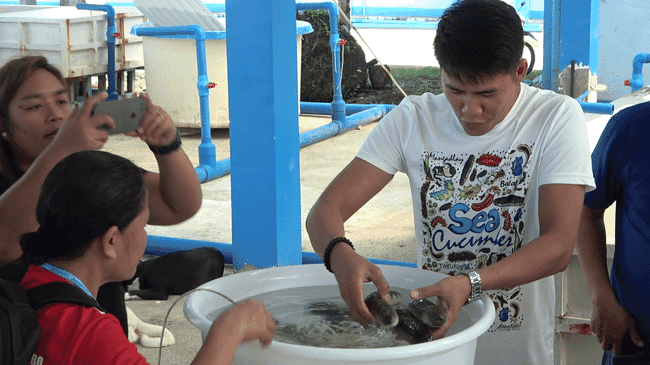
© SEAFDEC
To overcome hurdles hindering the mainstreaming of sea cucumber aquaculture production in the Philippines, the Southeast Asian Fisheries Development Center Aquaculture Department (SEAFDEC/AQD) - an international research organisation - conducted specialised training for technical staff nationwide on an innovative feeding strategy.
Sea cucumbers are a high-value species, with a kilogram of dried sea cucumber fetching over $1,000 in some markets. However, rampant overexploitation of wild stocks has led to concerning population declines, prompting aquaculturists to explore breeding technologies.
The primary cultivation bottleneck addressed by the programme is the unreliability of cultured microalgae as a live feed source for sea cucumber larvae. Cultured microalgae can be an excellent feed when plentiful, but cultures are sensitive to fluctuations in weather and water quality, which makes this food source unstable.
However, SEAFDEC/AQD research has shown that commercial microalgae concentrate, or algal pastes, are viable supplements, if not total replacements, for live microalgae as food for sea cucumber larvae. Concentrated microalgae are packed with up to 2 billion cells per milliliter and can be stored in ordinary refrigerators for months to be readily used for feeding at any time.
The training programme, held at the Guiuan Marine Fisheries Development Center, gathered 18 trainees who were equipped with practical skills to use algal pastes in growing sea cucumber larvae.
During the sessions - led by SEAFDEC/AQD researcher Dr. Jon Altamirano, along with research assistant Mr. Jesus Rodriguez - the participants were taken through lectures and practical sessions that provided hands-on experience in sea cucumber hatchery operations, focussing on the sandfish species (Holothuria scabra), which is one of the most threatened tropical sea cucumbers.
“Since the technology is already there, the Philippines should consider tapping into the economic potential of sea cucumber aquaculture, which, by the way, also has implications for ecological restoration,” said Dan Baliao, chief of the SEAFDEC Aquaculture Department, in a press release.
The pilot programme was co-organised by the Bureau of Fisheries and Aquatic Resources (BFAR) and the Guiuan Development Foundation, and was attended by technicians from various hatcheries around Leyte and Samar, as well as from project partners through the University of the Philippines-Marine Science Institute, and the Mindanao State University Naawan.




